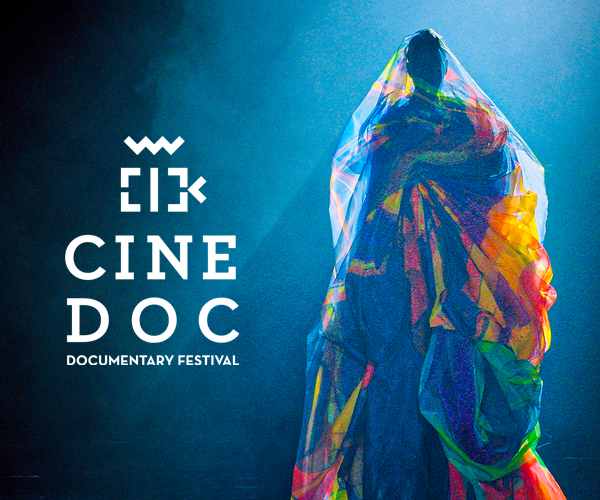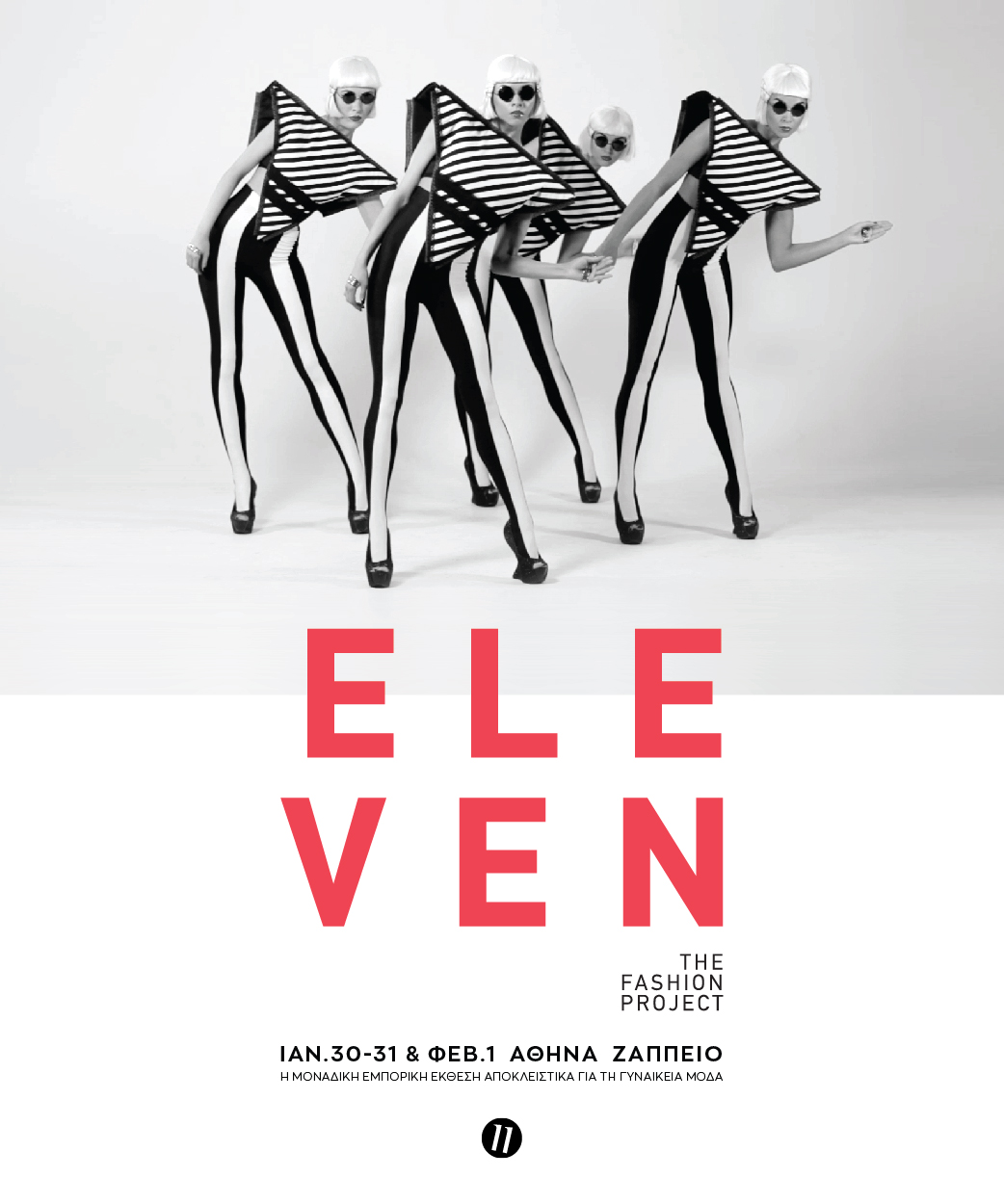Where Legends Live: A Day In The Athens Olympic Museum
- by XpatAthens
- Tuesday, 21 October 2025
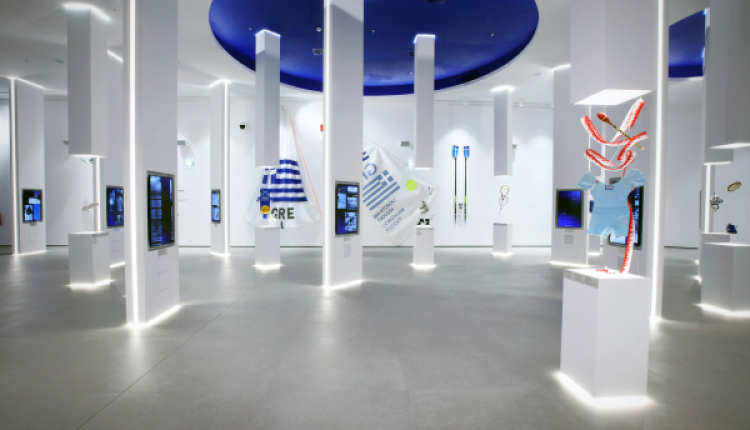
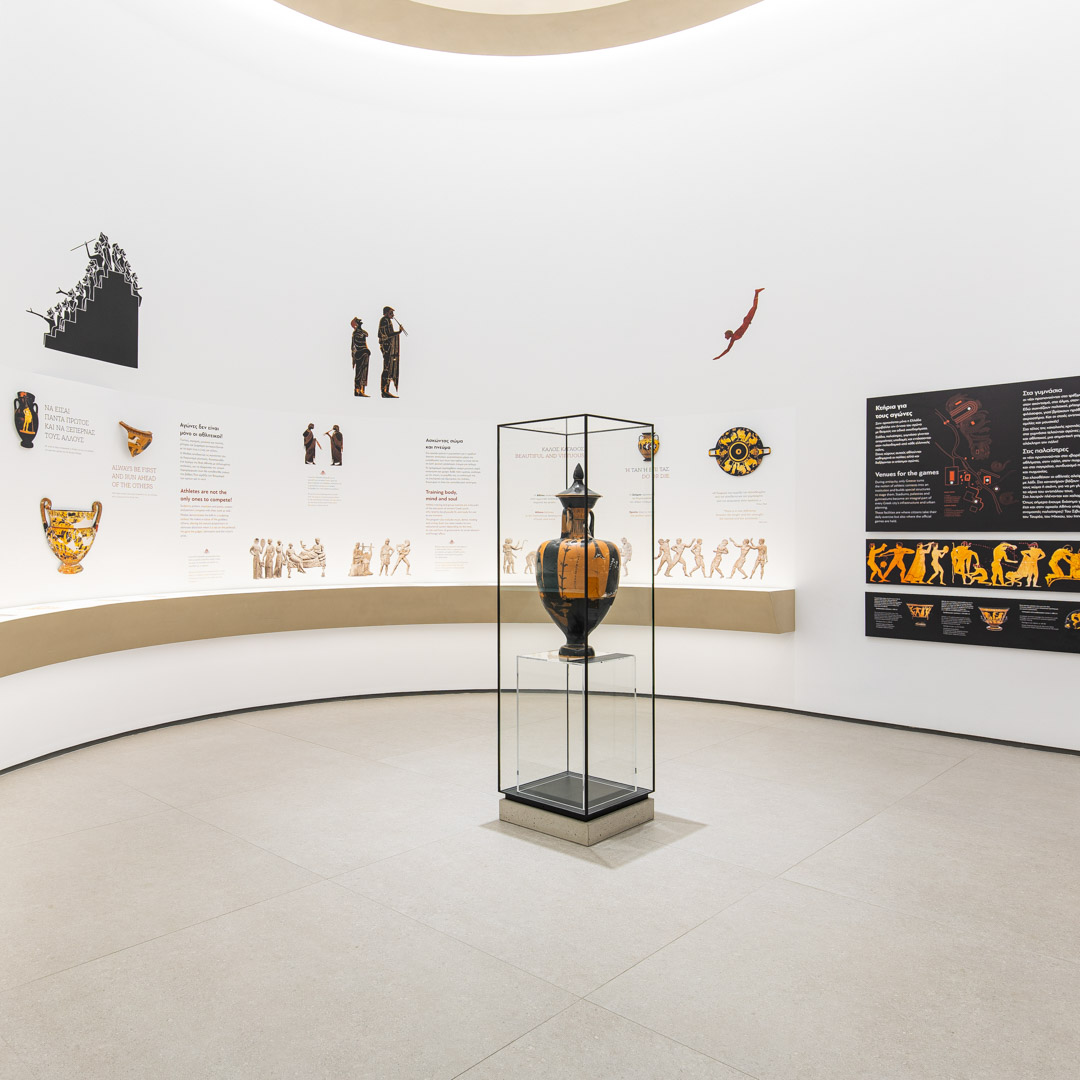
A Time Capsule Opens
The journey begins in a space that feels less like a gallery and more like a portal. The centerpiece is a 3D projection shaped after the κότινος, the olive wreath once placed on the heads of Olympic champions. Award-winning in its design using the technology of video mapping, the exhibit glows in the hushed light, alive with scenes and memories from past Olympics, accompanied by the music of Evanthea Reboutsika. Already, the past feels near enough to touch.
The second gallery resembles a cave, an otherworldly chamber where myths breathe again. Small “nests” shelter objects and stories: Hercules cleaning the Augean stables; Pelops charging forward in his chariot; the Curetes dancing, their shields clashing to drown out infant Zeus’ cries; and finally, the head of formidable Zeus, crowned with a wreath, a vision inspired by the lost golden statue.
From Myth to History
Stepping onward, we find ourselves surrounded by the world of competition throughout ancient Greek times. A great wall lays out the Panhellenic Games, not only the Olympics, but also the Isthmian, Pythian, and Nemean contests, as well as a special tribute to the Panathenaia. In this moment it becomes clear: this museum tells not just the story of the Olympics, but of Greece itself, and by extension, of the world.
On the opposite wall, Athens and Sparta confront one another in a timeless contrast. Athens proclaims καλός καγαθός, “beautiful and virtuous”, while Sparta answers with the uncompromising ἢ τὰν ἢ ἐπὶ τᾶς, “with your shield, or on it.” We also see an amphora, a faithful replica of those once full of olive oil, the treasured prize awarded to winners of the Panathenaic Games.
The fourth gallery adds a modern twist: an interactive video map. With a touch, we uncover the meaning of the sacred truce (ἱερή ἐκεχειρία) and read about the Discus of Ifitos, reminders that even in times of war, the Games called for cease of fire and harmony across the world.
Experiencing the Ancient Games
Then comes the fifth gallery, perhaps the most thrilling in the section of antiquty. Here, the stadium of Olympia unfolds before us in scale, and visitors are invited to run the δρόμος, the ancient sprint. High above, the statue of Nike by Paionios watches silently. The walls around us speak of rules: no biting, no foul play, and the ritual of ἀπαγορεύειν, where an athlete admitted his defeat by raising his finger.
The Hellanodikai, the judges of the Games, come into view, alongside the question: who could truly become an Olympic champion? At the tactile station, visitors can feel the shape of a κότινος olive wreath, or the crimson woolen ribbon once tied around the Olympic champions. The ribbon, it was believed, carried strength to its wearer. A “book of fame” completes the gallery, and we can turn the pages to reveal champions whose names still echo through time.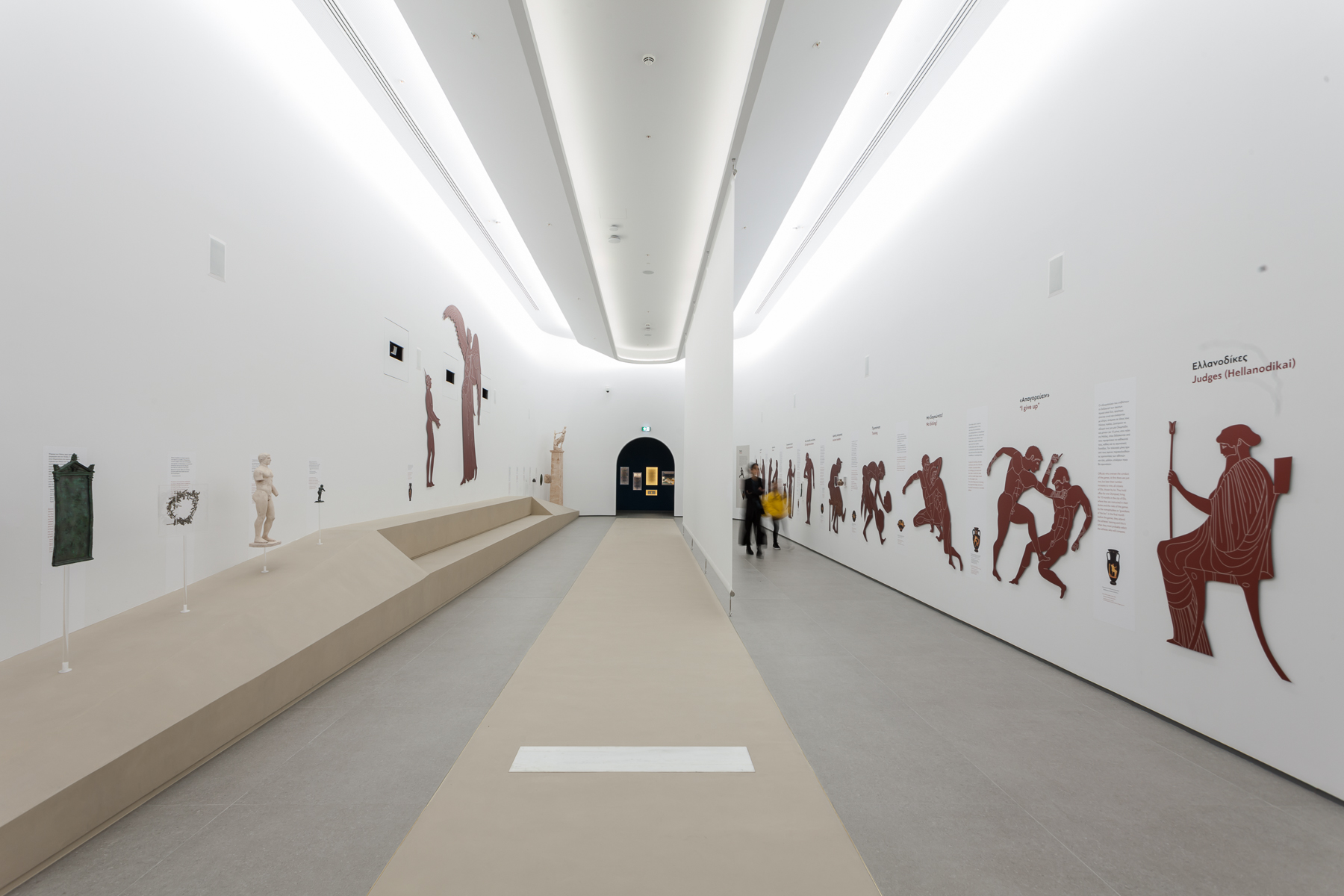
From Byzantium to the Revival
As we follow the route to the next gallery, the mood shifts dramatically. Designed to resemble a Byzantine church, with fonts, music, and aesthetics from the era, the gallery takes us from a period when the Games had faded and stopped, to the travels of the Europeans seeking to rediscover Olympia. A photograph of the excavations, bathed in light, symbolizes the rebirth of the ancient historical site.
The narrative continues with the path to the revival of the Games, leading us to Pierre de Coubertin and the Greek intellectual Demetrios Vikelas. Exhibits include extracts from their lengthy correspondence, Vikelas’ actual office desk, and a sizeable variety of documents from the 1896 Athens Olympics: letters, guides, flyers, and commemorative stamps on the occasion of that first modern celebration.
Into the Stadium Once Again
Next, we step inside a projection and exhibition hall designed as the Panathenaic Stadium. Sitting among its seats, we relive the atmosphere of the first modern Olympics. We learn how medals were originally awarded, with only the first two places recognized, as gold was introduced later in the history of the Games, and how participation was firstly limited to men.
We step into history as we learn all about the first modern Olympic Games of 1896. On the walls, we even see the figures of Harilaos Vasilakos and Spyros Louis, running towards the finish line—witnessing their struggle, their triumph, and their determination.
A Timeline of Every Games
In the next gallery, the story expands. A timeline of every Olympic Games edition - both Summer and Winter - unfolds before us, enriched with a collection of objects from each era, among which medals and athletes’ memorabilia. We learn so many meaningful facts and stories like how in 1932 Lake Placid, Mollie Phillips became the first woman to carry the British flag at the Winter Olympics. Or in 1964 Innsbruck, Italian bobsledder Eugenio Monti famously lent a part of his own sled to the British team, allowing them to win gold while his team took bronze, a story of true Olympic spirit.
Perhaps most exciting of all is the interactive touchscreens that let us explore what took place historically in the world during each Olympiad, proving once more that the Athens Olympic Museum is far more than a museum about the Games; it’s living chronicle of history itself.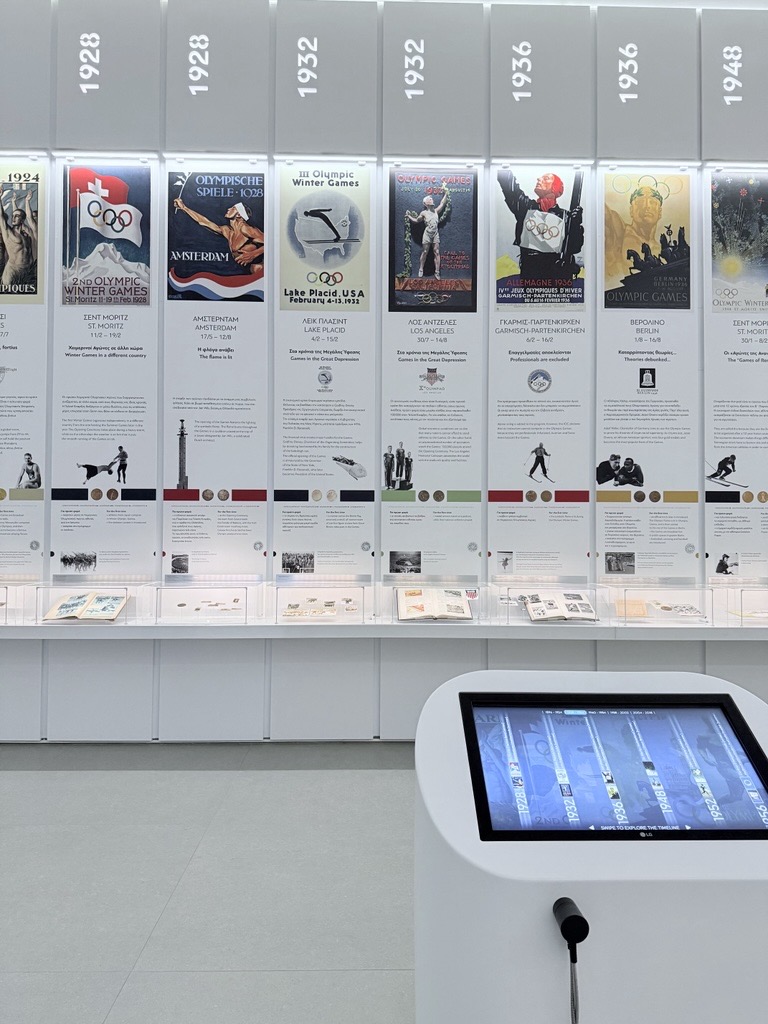
Athens 2004: The Games Return Home
Then, the journey brings us back home. The next exhibition gallery is an allusion to the Olympic Stadium of Athens (OAKA) and is dedicated to the Athens 2004 Olympics. We saw original sketches of Kouroudis’ Olympic sports “pictograms,” inspired by Cycladic figurines, as well as of the first medal engraving featuring Paionios Nike of Olympia ascending from the Panathenaic Stadium of Athens, designed by Elena Votsi; the permanent design of every summer edition ever since.
We follow the journey of the 2004 Olympic Torch Relay across all 5 continents, mapped in an artistic wall installation, and meet the mascots Phevos and Athena, inspired by the archaic ceramic daidala. On a video wall, we trace the massive public works that transformed Greece to host the Games.
The surprises continue: a parade of the original performers’ costumes, including the imposing Centaur, which the visitors can even touch, transfers us to the night of the Athens 2004 Opening Ceremony. Here also lies another treasure of memory, the medal of the decorated taekwondo Olympian Alexandros Nikolaidis, offered to the Museum for exhibition by his family.
And then, the focus shifts to the Athens 2004 Paralympic Games, presented through an audiovisual production and a collection of objects. A tactile station allows visitors to feel the 2004 Paralympics medal design featuring the Parthenon, and the neighborhood around the Acropolis, as well as a carefully reproduced larger tactile version making it accessible to visitors with visual impairments. This thoughtful detail captures the essence of the Games: accessibility, inclusivity, and the celebration of every athlete’s achievement.
Then the timeline of the modern Olympics continues in the next gallery where we encounter some empty slots waiting patiently to be filled with items of the future editions.
Kids will especially love the many close-up looks of the many mascots, before we see the Games motto in Latin that takes us to the next section of the exhibition. 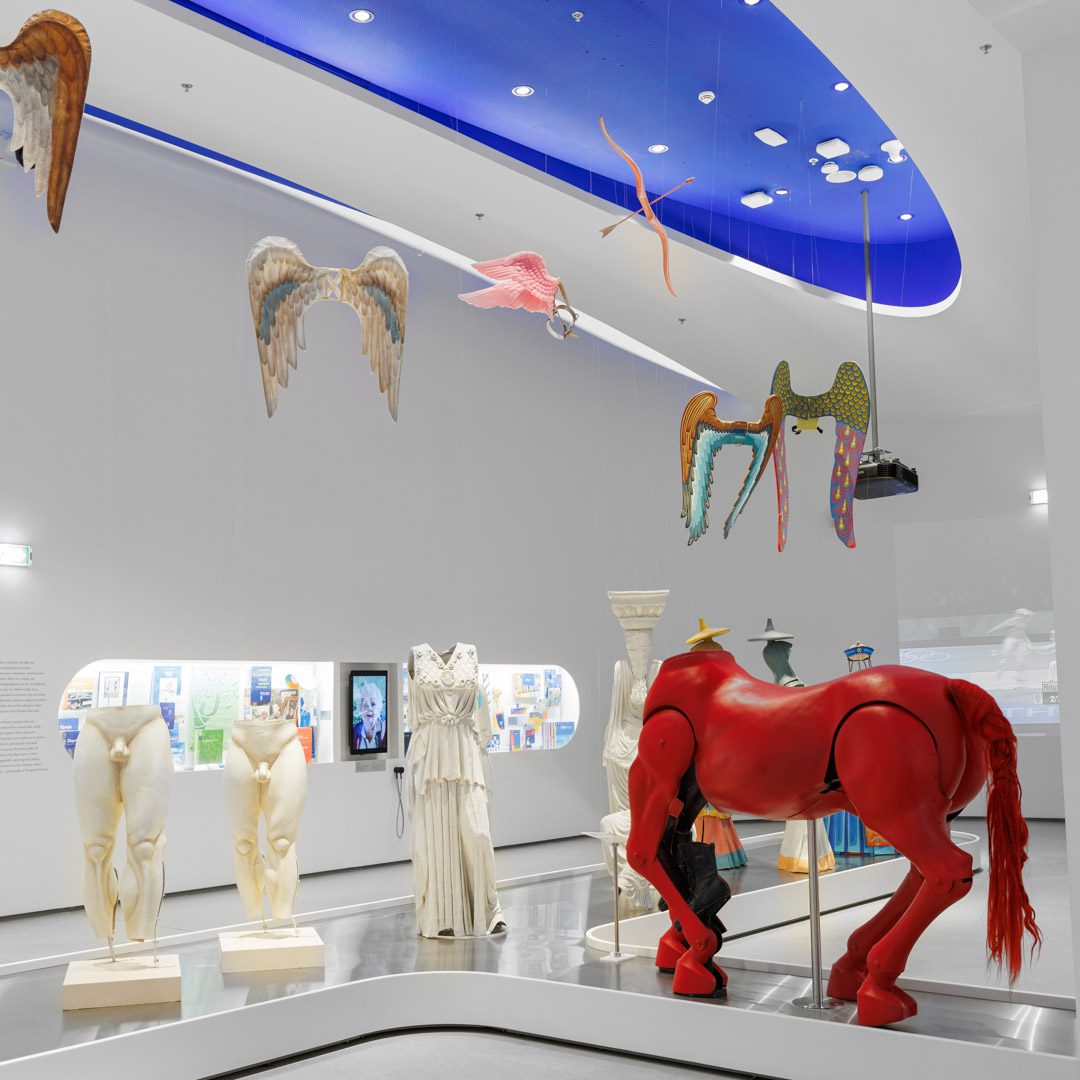
Symbols You Can Touch
The visit continues into a gallery where the Olympic symbols are presented together. Under the Olympic Flag we, again, find a tactile station, where visitors are invited to hold two original torches (δάδες) and to run their hands across the embossment of the Olympic rings symbol. For visitors with visual impairment especially, this is a revelation: the Games are not only something to watch, but something to feel, a universal language made tangible.
On display is the priestess’s chiton of Artemis Ignatiou, the current choreographer of the ceremony of the lighting of the Olympic Flame, a garment woven with tradition and ritual. Around us, the walls present the Museum’s collection of Olympic Torches, each design carrying its own meaning, each flame its own journey.
The visit in the gallery cannot skip the innovative central interactive installation, which received an Ermis award in 2021. It features a “seemingly unwritten” large book that come to life when its pages are flipped. The book is inspired by the Olympic Charter and vividly presents the Olympic Movement, the symbols and the philosophy of Olympism.
Stories Stitched in Fabric
In the next gallery, we find two large digital stations that let us dive deeper in discovering the stories of every Greek Olympic and Paralympic medalist, their victories, and seeing excerpts from their performances. Around the gallery we see their performance apparel and equipment from their participation to the Games, some instantly recognizable, others less known, like the Paralympic sport boccia. Before us the tribute to one of the legends: Pyrros Dimas, with the entire collection of the singlets he wore across his Olympic career. Then inclusivity takes center stage. At first glance, a simple piece of equipment whose purpose isn’t obvious. But then its significance soon emerges: it is the running tether worn by the blind sprinter Paraskevi Kantza, the link connecting her to her guide as they competed side by side. Suddenly, it’s no longer just an object, but a story of resilience, determination, trust, and teamwork. 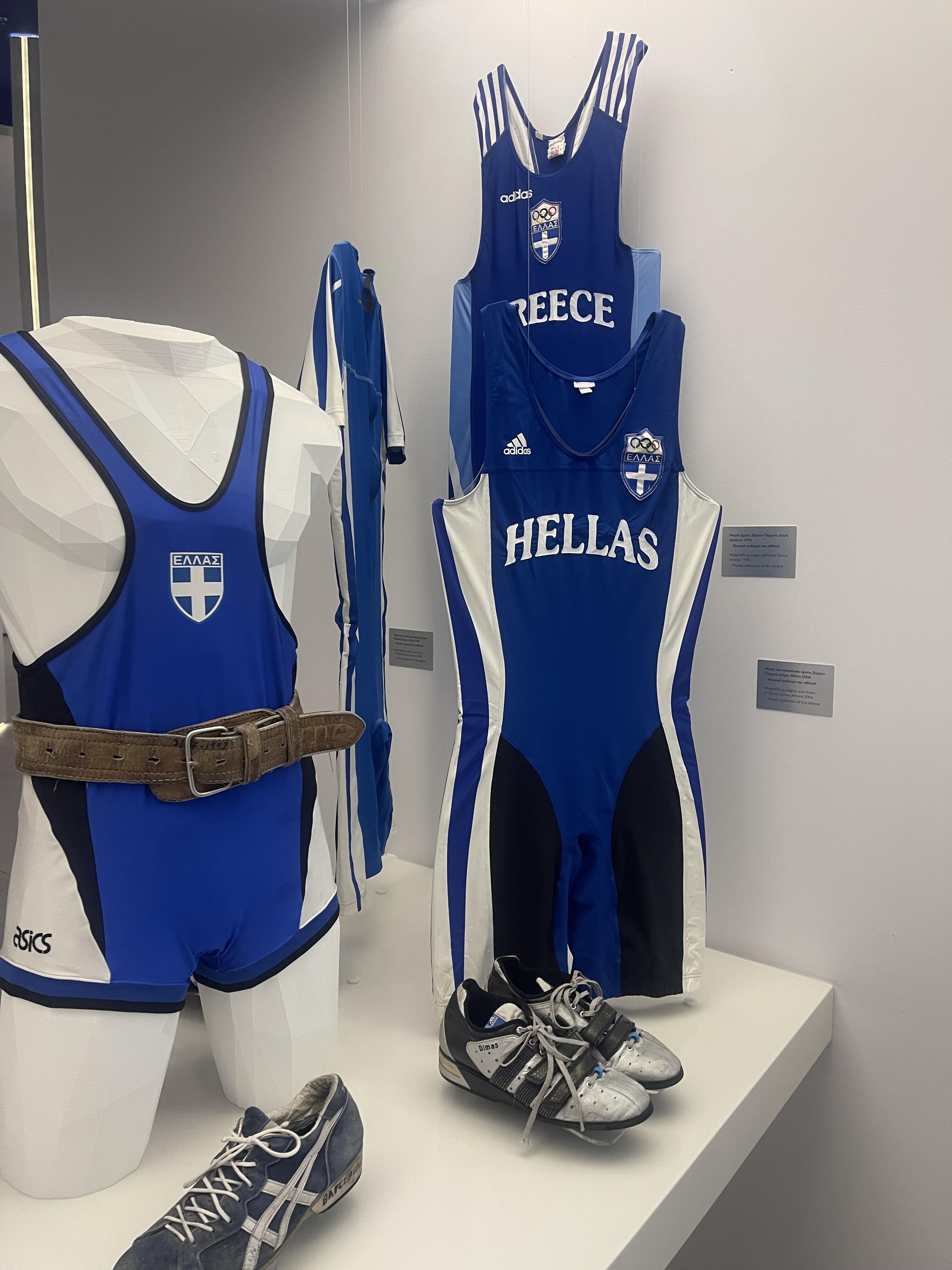
Become an Olympian
This is where the exhibition shifts from being a spectator to being a participant. We are invited to become athletes ourselves, to use a real Olympic bow in archery (Summer Olympics), to feel the rush of wheelchair racing (Paralympics), and to balance ourselves on the slopes in skiing (Winter Olympics).
For children, especially, this is a revelation: to learn by doing, to understand how difficult -and how extraordinary - the life of an athlete truly is.
The back wall glows with a Hall of Fame, but it is not only about medals and records. In the same gallery we meet athletes as people, their struggles as real as their triumphs. We learn about Michael Phelps, who faced the shadows of depression even as he stood on the podium and how Nikolaos Kaklamanakis thought his greatest rival was none other than himself. The exhibition host his sail of the 2004 Games, centrally presented in front of a mirror that is there to remind us that we too battle our own rivals within.
This is where the line between athlete and visitor blurs, as we can see our paths from the perspective of their stories.
An Inspiring Farewell
The exhibition closes with a large audiovisual show. An audiovisual production without words, without narration, sweeps across the large screen. We see some of the most powerful moments in Olympic history: the struggle of the athletes such as the emblematic barefoot marathon runner Abebe Bikila, the tears, the embraces, the impossible victories. With no explanation, only music, the images speak directly to the heart.
And so, the tour ends where it began, with silence, with awe, with the timeless flame of the Olympic spirit.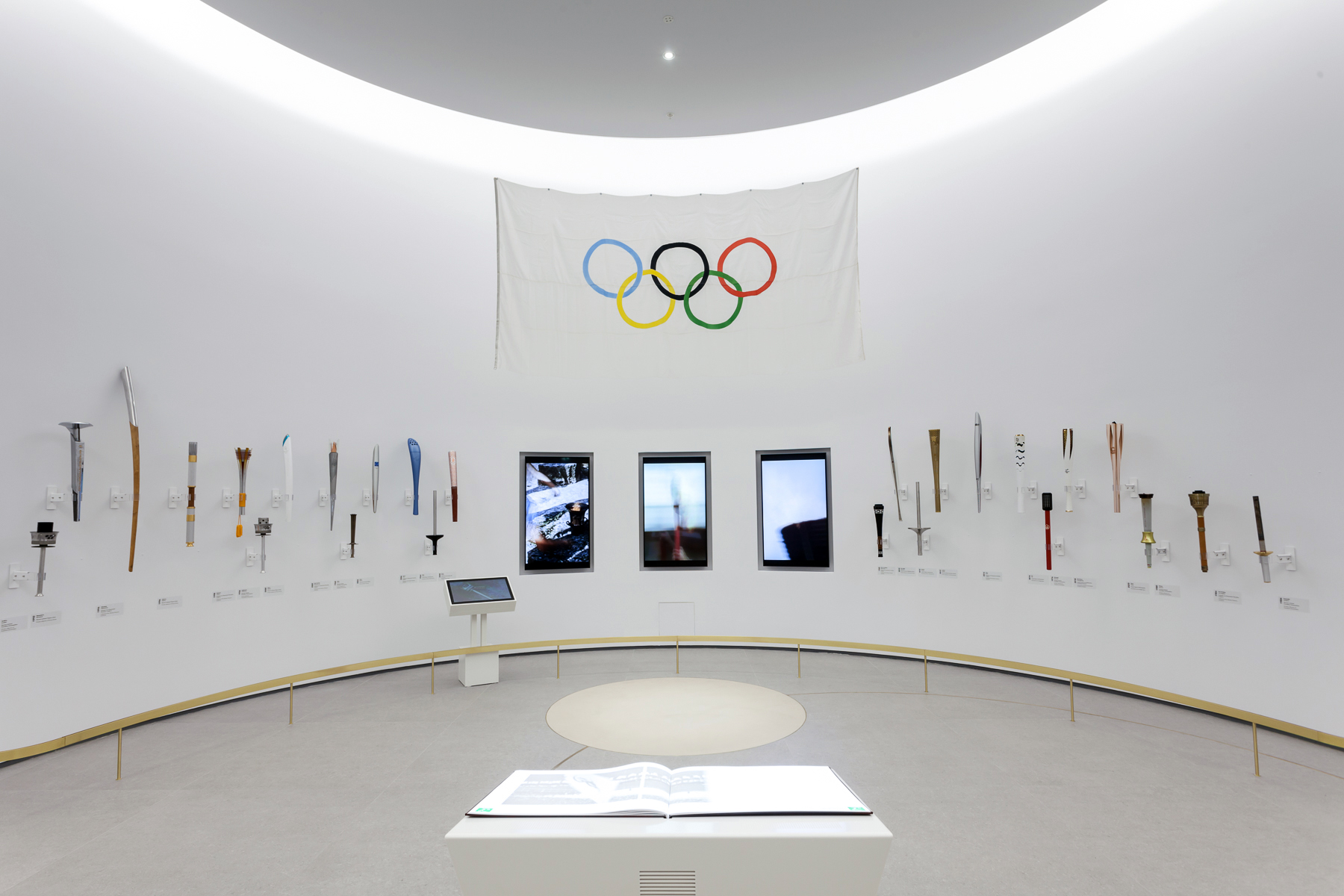
A Must-Visit for Everyone
What struck us most about the Athens Olympic Museum is how every detail has meaning. Nothing is random: every gallery, every symbol, every object is part of a carefully curated story. We loved how seamlessly it blends myth, history, personal stores and living memory into one journey. For children, blind and visually impaired visitors, the tactile stations, audio descriptions and narrations, as well as the interactive exhibits make the experience deeply, movingly inclusive and the Games’ stories accessible in a way that truly touches the heart.
The museum’s reach extends far beyond its walls. Its educational program “Μουσειοβαλίτσα” (AOM Suitcases) available in Greek, English, French, Arabic, and Farsi, brings the Olympic ideals to every classroom, group and community it reaches. Meanwhile, Live online Tours bring the history of Olympism to every corner of the globe. It’s a reminder of its mission to share values of inclusivity, excellence, and peace across languages and cultures. And yet, as much as we saw, we realized we had barely scratched the surface. The exhibition is so rich, the storytelling so layered, that the just one visit feels like an introduction, a welcome to the world of Olympism. We left with the sense that we must return, because there is always more to learn, more to feel, and more to discover in this place where history, humanity, and hope meet. The Olympic Museum is not just worth visiting; it is worth visiting again and again.

